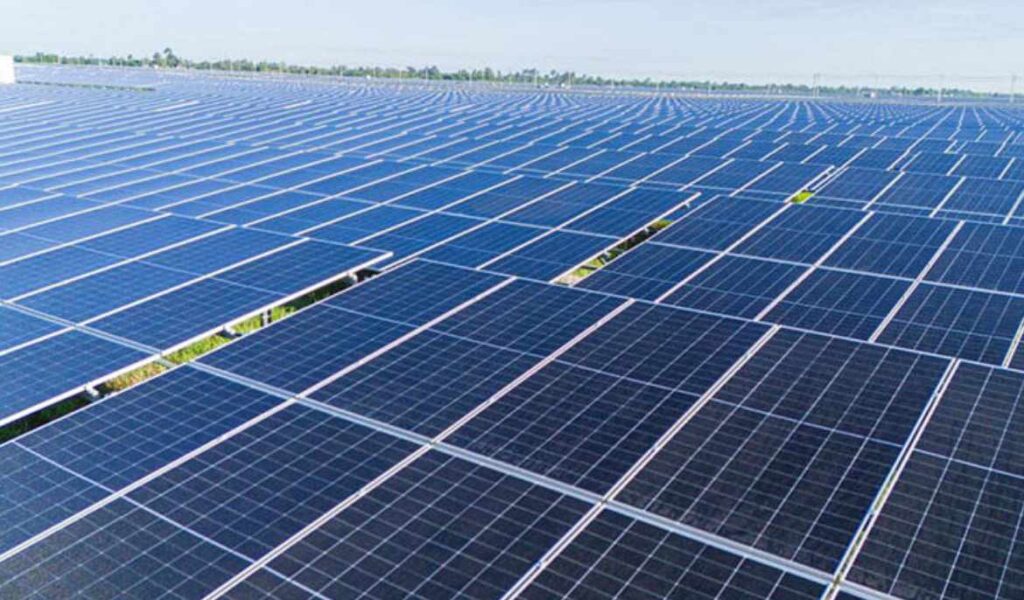Synopsis: The plant will play a crucial role in supporting Pursat’s rising electricity consumption, and help advance Cambodia’s carbon neutrality goals.
A 10-megawatt solar power plant with an integrated battery storage system, developed by SchneiTec ZEALOUS, was officially inaugurated on Friday, marking a significant milestone in Cambodia’s transition towards clean and sustainable energy.
The inauguration ceremony, held at the project site in Krakor district, Pursat province, was presided over by Keo Rottanak, Minister of Mines and Energy, Khoy Rida, Governor of Pursat province and Ueno Atsushi, Japanese Ambassador to Cambodia.
The event drew the participation of senior government officials, directors general, company representatives, local leaders, civil servants, members of the armed forces, teachers, students, and a large number of residents.
Governor Rida said Pursat province is now recognised as one of Cambodia’s leading electricity producers, powered by both solar and hydro sources. The province hosts three major energy sites, supplying electricity locally and for export.
He stressed that this achievement is the result of the vision and leadership of the government. Their combined efforts have brought investment, boosted economic growth, and transformed Pursat from a transit point into a thriving hub for industry and tourism.
Ambassador Ueno Atsushi commended Cambodia’s long-term strategy to achieve carbon neutrality by 2050, which includes ambitious measures to cut greenhouse gas emissions. He emphasised that renewable energy projects, such as the Pursat solar power plant, are vital to meeting these targets.
“The facility’s integrated battery storage system will not only help Cambodia manage its growing electricity demand but also ensure a more reliable and stable energy supply,” he said. “Under the Japan-Cambodia Joint Crediting Mechanism (JCM), the project will contribute to emission reductions in both countries, making it a ‘win-win’ partnership.”
Rottanak noted that since Prime Minister Hun Manet took office in August 2023, the government has worked to diversify Cambodia’s economic partnerships, with Japan being a key focus. The project, funded by Chugoku Electric Power Company—one of Japan’s major electric utilities—in collaboration with SchneiTec ZEALOUS, is a prime example of this cooperation.
He said the plant will play a crucial role in supporting Pursat’s rising electricity consumption, feeding into the national grid, promoting renewable energy adoption, ensuring a steady supply from low-carbon sources, and advancing the Kingdom’s carbon neutrality goals.
“This project is a testament to the shared vision of Cambodia and Japan in building a cleaner and more sustainable energy future,” he added.
It is also worth noting that Cambodia is accelerating its transition to clean energy, with solar farms expected to double their electricity contribution to the national grid this year.
According to the latest report from the Electricity Authority of Cambodia (EAC), solar farms are projected to generate around 720MW of electricity for the grid in 2025, compared to 827MW in 2024.
The government is advancing the development of new energy projects to boost the share of clean energy, aiming to increase renewable generation capacity to 70 per cent by 2030 from the current level of just over 62 per cent. Achieving this target would place Cambodia second among ASEAN nations, excluding Laos, for the highest proportion of clean energy, delivering a wide range of environmental and economic benefits.
The expansion of solar power aligns with national policy to achieve carbon neutrality by 2050. Since 2019, no new licences have been issued for coal-fired power plants.
The country’s primary renewable sources include hydropower, solar energy and biomass, supplemented by electricity imports from neighbouring countries, particularly during the dry season.
Under the Power Development Master Plan (PDP) 2022-2040, the Royal Government has confirmed that no new coal power projects will be approved after 2024, with renewable energy set to play a central role in the country’s future supply.
In September last year, approval was granted for 23 new power investment projects with a combined capacity of 5,950MW, aimed at addressing energy shortfalls.
Cambodia’s total installed electricity capacity reached 5,044MW in 2024, an increase of 8.5 per cent from 4,649MW in 2023. In 2025, capacity is planned to rise further to 6,044MW.



